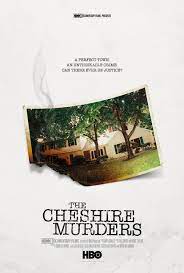
THE CHESHIRE MURDERS
US, 2013, 118 minutes, Colour.
Directed by Kate Davis and David Heilbroner.
A thought-provoking documentary.
The murders took place in Cheshire Connecticut in 2007, a brutal home invasion by two known criminals, the bashing of the father, the sending of the mother to a bank to get ransom money and then her murder, the rape and murder of the two daughters, the setting of the house on fire, the taking of the family car, its crashing and their being arrested. After some years in prison, each of the men was tried and found guilty and received the death penalty.
This is not a crime investigation documentary. It is clear from the beginning what happened. And the men confessed.
The film uses a great deal of archival footage to reconstruct the situation, especially in the latter part of the film going through the events hour by hour. There is criticism of the local police force and their slowness to respond, possibilities of saving the victims. The husband, severely bashed and injured, surviving.
As expected, there are many talking heads and interviews, especially effective the extensive scenes with the murdered woman’s sister. And, there are interviews with her mother and father, he a Reverend. And, throughout, many interviews with the father, a doctor.
And, there are many talking heads on the legal issues, psychiatrists and their opinions of the two men, defence lawyers, prosecutors.
While the audience learns a great deal about the murdered family, family footage, and much sympathy, there is also a great deal about the two criminals, their lives, archival material, photos, their both being abused as children, their psychology, a history of viciousness, even violence – and the brothers of one of the criminals telling of the betrayal history by the brother and their being available to give testimony against him to the police. There is also testimony by this criminal’s daughter, her love for her father, yet her alienation from him. The younger man, the more vicious, is spoken about by some women who dated him in the past.
And, ultimately, this is a film about justice and punishment.
There is great feeling about the death penalty, especially from the surviving husband. However, the film raises the dilemma about life imprisonment and the death penalty, discussions at the time in the state of Connecticut about the abolition of the death penalty, the governor reaffirming it, but, ultimately, the abolition. The dilemma is strongly noted and left to the audience to make up its mind.
If the two men pleaded guilty, they would not have to go to trial, would get a life sentence without parole, there would be no need for trials and for the long processes going over the situation in detail, with the consequent pain for the family. With a life sentence, no public delving into the details of the crimes and the criminals left forgotten in prison.
What happened was that there were preliminary hearings, going to trial, a great deal of evidence, and the photos taken too grim for publication, to be seen only by the juries. This meant that the family had years of living with the trials and the memories of the crime. And, after the jury’s verdict of guilty, the possibilities of appeals and the whole processes going on for years.
The film asks which would have been the best solution for justice and for grief.